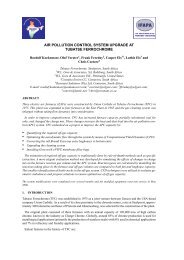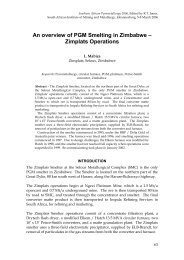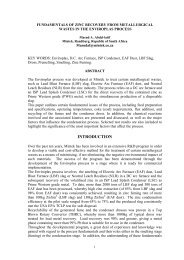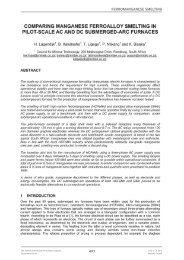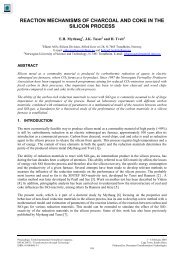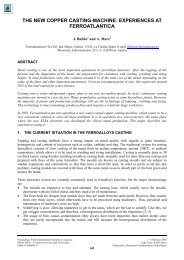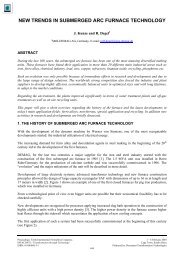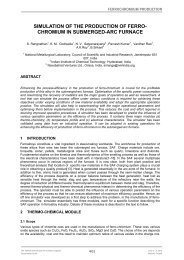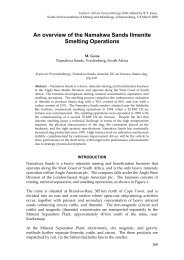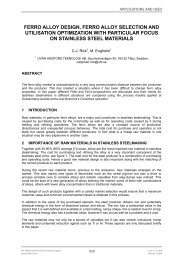4. PILOT AND COMMERCIAL SCALE TESTSKawasaki <strong>Steel</strong> [12] developed a dust treat<strong>in</strong>g process (STAR process), utiliz<strong>in</strong>g the <strong>co</strong>ke packed bed typesmelt<strong>in</strong>g reduction. In this process tuyeres are provided at two stages. The powdery sta<strong>in</strong>less steel sludge(daily <strong>co</strong>nsumption is 140t) and dust is <strong>in</strong>jected through the upper tuyere and heated by the fuel suppliedfrom the lower tuyere (Figure 10).Figure 10. Pr<strong>in</strong>ciple <strong>of</strong> STAR Process [12].They are re<strong>co</strong>ver<strong>in</strong>g iron <strong>co</strong>nta<strong>in</strong><strong>in</strong>g C 3.9-4.2, Cr 7.7-8.5, Al 1.4-1.8 mass% and slag <strong>co</strong>mposition is T. Fe0.18-0.27, Cr 0.12-0.18, CaO 37-38, SiO 2 36-37, Al 2 O 3 14 mass% with chromium yield <strong>of</strong> 98%. This is<strong>co</strong>mmercial equipment which greatly <strong>co</strong>ntributes to establish their environment <strong>co</strong>nscious production <strong>of</strong>sta<strong>in</strong>less steel.Tschud<strong>in</strong> and Brotzmann [13] developed the HSR (Holsim Smelt<strong>in</strong>g Radix) process, which essentiallyreduces chromium oxide <strong>in</strong> sta<strong>in</strong>less steel slags <strong>in</strong> a BOF type furnace with blow<strong>in</strong>g oxygen and powdery<strong>co</strong>al through bottom and top blow<strong>in</strong>g <strong>of</strong> air (Figure 11). Typically, 3t <strong>of</strong> premelted slag was charged onto 10t<strong>of</strong> Fe-Cr-Cr metal from the previous heat. The chromium <strong>co</strong>ntent <strong>of</strong> the slag was lowered from 4.7 to 0.2mass% with 96.5% yield. If needed, further reduction by Fe-Si (0.4kg Si per kg Cr <strong>in</strong> slag ) lowered thechromium <strong>co</strong>ntent down to 0.02 mass%. This 0.4kg <strong>of</strong> Si is <strong>in</strong> ac<strong>co</strong>rd with stoichiometic calculationexclud<strong>in</strong>g the one needed to keep the sili<strong>co</strong>n <strong>co</strong>ntent at 2 mass% which is the calculated sili<strong>co</strong>n <strong>co</strong>ntent toatta<strong>in</strong> 0.02 (% Cr) by slag-metal equilibration under their <strong>co</strong>nditions. This aga<strong>in</strong> suggests that ferrosili<strong>co</strong>nreacts directly with chromium oxide <strong>in</strong> slag before dissolv<strong>in</strong>g <strong>in</strong>to a metal bulk. They <strong>co</strong>uld adjust the slag<strong>co</strong>mposition with CaO/SiO 2 =1.2~1.3 and mass%Al 2 O 3 =13 for use as a cement material. Leachability <strong>of</strong>Cr 6+ from a cement <strong>co</strong>nta<strong>in</strong><strong>in</strong>g 50% <strong>of</strong> this type slag was tested and they found that its leachability was 50%less than for ord<strong>in</strong>ary portland cement. The existence <strong>of</strong> (Cr 3+ )after reduction under strongly reduc<strong>in</strong>g<strong>co</strong>nditions is the reason for this f<strong>in</strong>d<strong>in</strong>g <strong>in</strong> ac<strong>co</strong>rdance <strong>of</strong> blast furnace slags.Figure 11. Consumption figures for treatment <strong>of</strong> 1t liquid <strong>in</strong>put <strong>of</strong> sta<strong>in</strong>less steel slags (HSR process) [13].
Burstron and Ye [13] tested the reduction for <strong>of</strong> chromium oxide <strong>in</strong> a 5t DC furnace at MEFOS (The IPBMprocess).Their typical slag <strong>co</strong>mposition is as follows. Fe 0.35, CaO 56.6, SiO 2 19.6, MnO 1.18, P 2 O 5 0.2, Al 2 O 3 21.9,MgO 2.85, Cr 2 O 3 0.03 mass% and slag temperature was 1953K.5. DISCUSSIONSAs reviewed above, carbon is the most realistic choice as a reductant <strong>of</strong> chromium oxide when iron is used asan absorber <strong>of</strong> reduced chromium. Thermodynamically as carbon <strong>co</strong>ntent decreases, its reduct<strong>in</strong>g powersignificantly drops. The metal after reduction may be recycled as long as the reduction furnace is locatednear a sta<strong>in</strong>less steel mak<strong>in</strong>g furnace. S<strong>in</strong>ce heat resource is the most important factor for treat<strong>in</strong>g slags, thisis an <strong>in</strong>dispensable <strong>co</strong>ndition.When sili<strong>co</strong>n is used as a reductant, two different mechanisms are possible, whether (1) ferrosili<strong>co</strong>n directlyreacts with slag or (2) it dissolves <strong>in</strong>to the metal and then sili<strong>co</strong>n <strong>in</strong> metal reacts with slag or a mixture <strong>of</strong> (1)and (2).Thermodynamically, the former case has a much higher sili<strong>co</strong>n activity than the latter. In the former case,formation <strong>of</strong> silica film on ferrosili<strong>co</strong>n particle dur<strong>in</strong>g reduction would leave it undissolved, result<strong>in</strong>g <strong>in</strong> loss<strong>of</strong> efficiency . In both cases, the necessary amount <strong>of</strong> ferrosili<strong>co</strong>n is the sum <strong>of</strong> (a) that used for reduction and(b) that to keep the sili<strong>co</strong>n <strong>co</strong>ntent high enough to keep the oxygen potential low. For example, slag<strong>co</strong>nta<strong>in</strong><strong>in</strong>g 25 mass% Cr 2 O 3 is reduced to 3% at 1923K, (a)12.2 and (b) 0.5kg/t <strong>of</strong> sili<strong>co</strong>n (total 12.7kg/t) arerequired, respectively, where the <strong>co</strong>exist<strong>in</strong>g metal <strong>co</strong>nta<strong>in</strong>s C 0.7%, Cr 16%, and Si 0.05 mass%. Actually12~13kg <strong>of</strong> sili<strong>co</strong>n as ferrosili<strong>co</strong>n(70~75%Si) is fed onto the slag [14]. Thermodynamically theequilibrium Cr 2 O 3 <strong>co</strong>ntent is calculated as 14 mass%, which is far higher than the obta<strong>in</strong>ed <strong>co</strong>ntent <strong>of</strong> 3mass%. In this case sufficient mix<strong>in</strong>g is desirable for effective reduction between Fe-Si and slag. When 1t <strong>of</strong>the slag <strong>co</strong>nta<strong>in</strong><strong>in</strong>g 3% Cr 2 O 3 is <strong>co</strong>mpletely reduced to harmless level <strong>of</strong> 0.05 as % (Cr) with 1 %Si <strong>in</strong> themetal, 44kg <strong>of</strong> sili<strong>co</strong>n is needed, if the weight ratio <strong>of</strong> slag to metal is 0.3. If the ratio can be <strong>in</strong>creased to 1,the needed sili<strong>co</strong>n amount would decrease to 20kg. Therefore the treatment should be done with a smallamount <strong>of</strong> metal.As a result, the best process would be reduction by carbon saturated iron with a small addition <strong>of</strong> sili<strong>co</strong>n atthe end. In this case the slag is treated after separation from sta<strong>in</strong>less crude metal where the method <strong>of</strong> heatsupply is most important. Therefore reduction should be carried out near a sta<strong>in</strong>less steel mak<strong>in</strong>g furnacebefore the slag solidifies. As <strong>in</strong> the HSR process, oxygen on air blow<strong>in</strong>g with some carbonaceous fuel wouldbe a solution.Thermodynamically alum<strong>in</strong>um is the best reductant except for <strong>co</strong>st. Industrial waste such as alum<strong>in</strong>um drossmay be used if it is available near location <strong>of</strong> a sta<strong>in</strong>less steel plant.6. CONCLUSIONSIn this paper the reduction <strong>of</strong> chromium oxide sta<strong>in</strong>less steel slags was shown to be technically feasible byreview<strong>in</strong>g fundamental knowledges for smelt<strong>in</strong>g reduction <strong>of</strong> chrome ore <strong>in</strong> the past and the results <strong>of</strong> recentpilot plant tests.The only problem to be solved is how to supply heat for treatment after separation <strong>of</strong> the bulk metal. S<strong>in</strong>cethe price <strong>of</strong> treated slag is not expected to be high, a large <strong>in</strong>vestment may not be possible. However, theauthor believes that <strong>in</strong> order to <strong>co</strong>nt<strong>in</strong>ue to produce sta<strong>in</strong>less steel without much <strong>co</strong>ncern <strong>in</strong> future an<strong>in</strong>troduction <strong>of</strong> the slag treatment process is <strong>co</strong>mpulsory and some <strong>in</strong>vestment may be worthy to establish anenvironment <strong>co</strong>nscious process.



